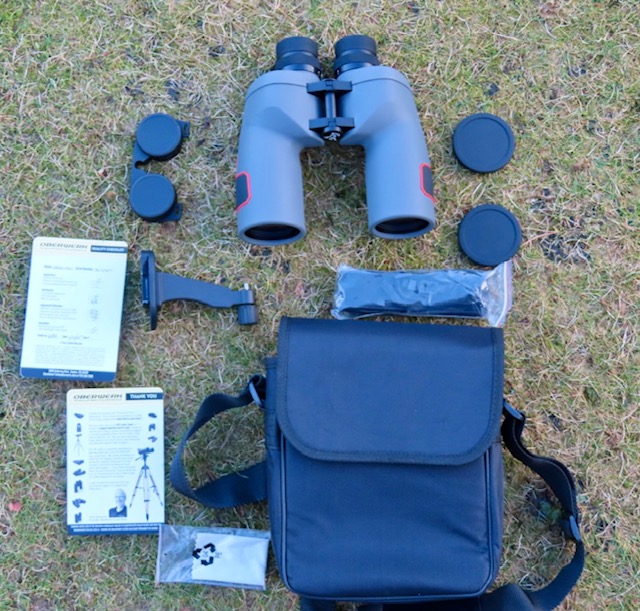
A Work Commenced February 11 2025
Product: Oberwerk ED Ultra 15 x 56
Country of Manufacture: China
Clear Aperture: 56mm(measured)
Exit Pupil: 3.73mm
Field of View: 88m@1000m(4.7 angular degrees)
Close Focus: 15m advertised, 17.4m measured
Focuser Configuration: Individual Focus(IF)
Coatings: Fully Broadband Multicoated
ED glass: Yes(FK-61)
Field Flatteners: Yes
Prism Type: BaK
Waterproof: Yes
Nitrogen Purged: Yes
Weight: 1.48 kilos
Accessories: Padded soft case, mounting bracket, rain guard, objective caps, neoprene neck strap, microfibre lens cloth, test & warranty certificate.
Warranty: 5 Years
Price(UK) £549.95
When it comes to large, high-power binoculars, Oberwerk is a name that trips off the tongue. For a quarter of a century, its founder, Kevin Busarow, has been servicing the astronomical community with a swathe of innovative products that deliver excellent value for money. One of the most admirable attributes of Oberwerk is their commitment to developing their optical wares as new technologies become available.
The original Oberwerk Ultra models had good achromatic optics, full sized prisms and housed in a robust, weatherproof chassis. Fast forward a decade and the same series now possesses extra-low dispersion objectives and field-flattening optics with significantly improved eye relief for eyeglass wearers.
Another point of significance is Oberwerk’s commitment to the Porro I prism design, which has several advantages over larger aperture roof prism models. For one thing, because the eyepieces of roof models are aligned with their objectives, their minimum IPD becomes progressively larger as the aperture exceeds 50mm. A 70mm roof would probably have an IPD near 70mm meaning that many users, yours truly included, could not bring the barrels close enough together to merge the images. That’s not an issue for Porro I prism designs, the objectives of which have large offsets to allow the majority of human faces to engage with them.
In addition, larger roof prism binoculars of high optical quality are more expensive than a well executed Porro I model of equal quality.
Having tested hundreds of binocular models – both roof and Porro – particularly under the stars- I have cultivated a strong preference for Porro prism models in larger apertures. Stars present as tinier pinpoints without the commonly seen diffraction spikes all too often witnessed in many roof prism models.
So when Oberwerk launched their new ED Ultra Series of Porro I system binoculars, I became particularly intrigued by one model: the 15 x 56, for reasons I shall elaborate on later. What follows is a detailed review of this instrument, based on a couple of months of experience during daylight hours, but also after dark.
A Closer Look at the Oberwerk ED Ultra 15 x 56
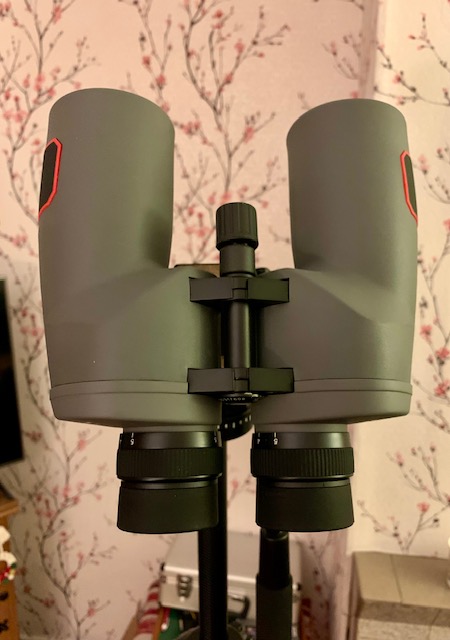
The Oberwerk ED Ultra is an exceptionally handsome and beefy binocular, tipping the scales at 1.48kg. The tough magnesium alloy chassis is overlaid by an attractive grey textured rubber armouring, with black and red accents placed at the sides of the barrels.
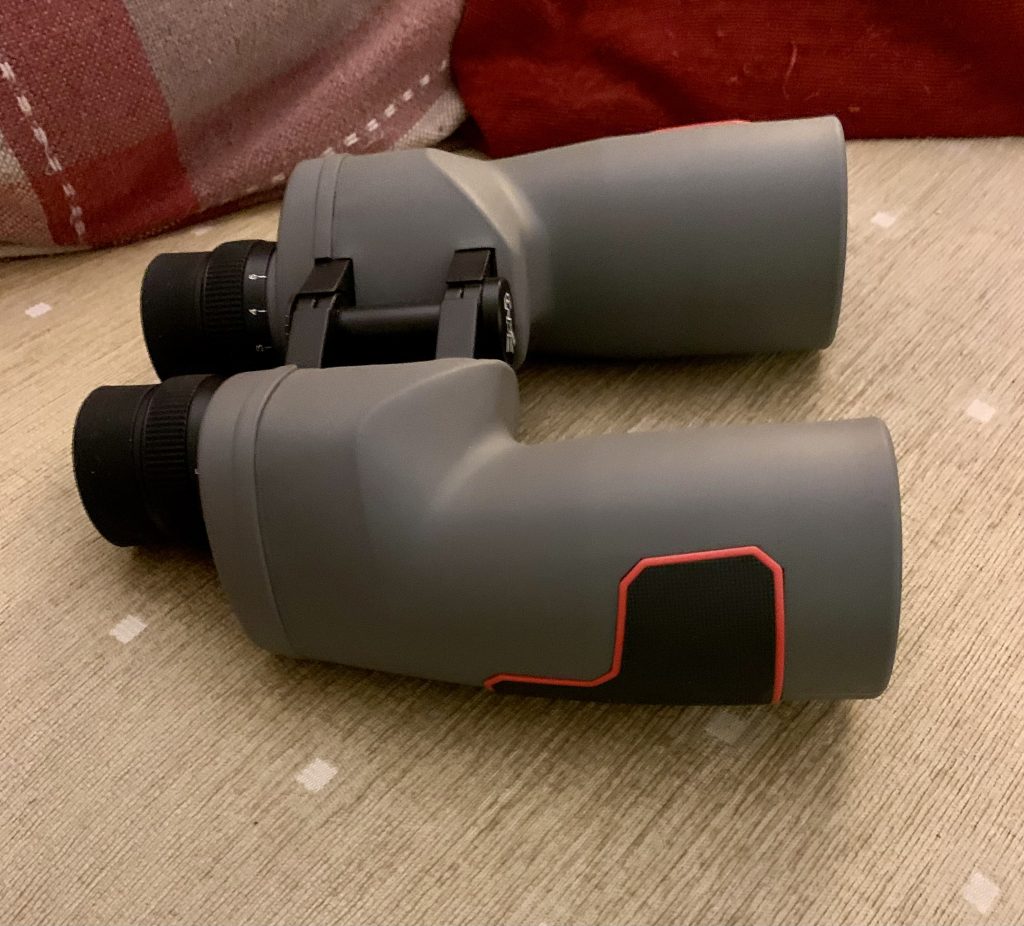
The eyepieces are focused individually and are clearly marked with their +\- 5 dioptre compensations. They rotate smoothly and accurately, maintaining their positions well. The eyecups are fashioned from black rubber and have plenty of useable eye relief. Folded down, I was able to easily engage with the entire field using spectacles. Indeed I later found that while I do not use eyeglasses while looking through binoculars, I strongly preferred using the 15 x 56 with the eyecups folded down, as shown below:
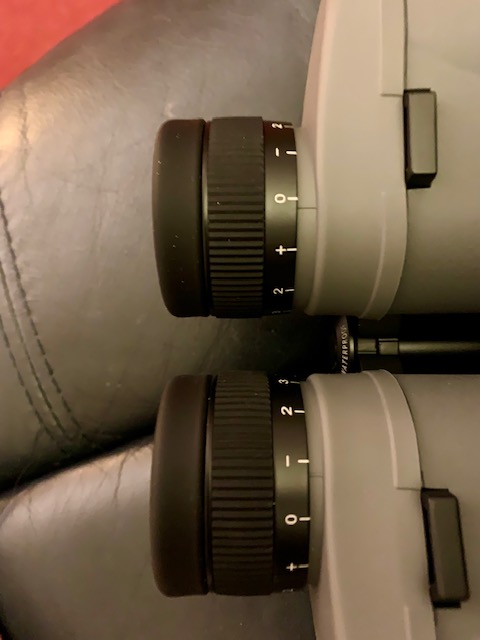
While it is certainly true that Porro prism binoculars are more prone to being whacked out of alignment, these new Ultra ED models possess a 3-point floating plate housing for the full-size BaK 4 prisms at the heart of the instruments. That’s very reassuring, as this will almost certainly mean these models will hold precise collimation indefinitely.
Both the objective and eyepiece lenses exude attractive pink coloured anti-reflection coatings, very similar in fact to their excellent SE series instruments.
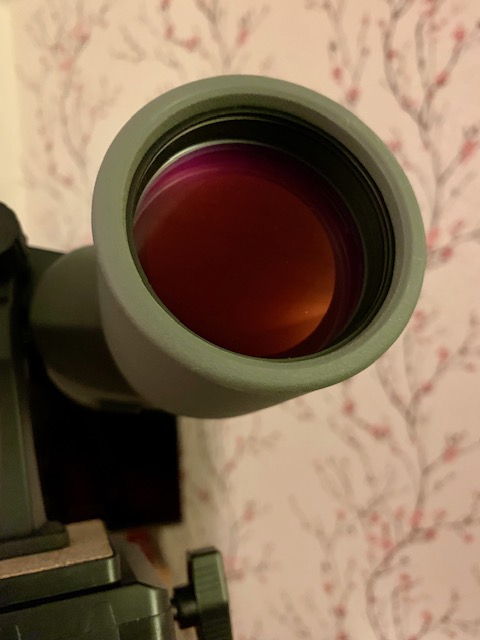
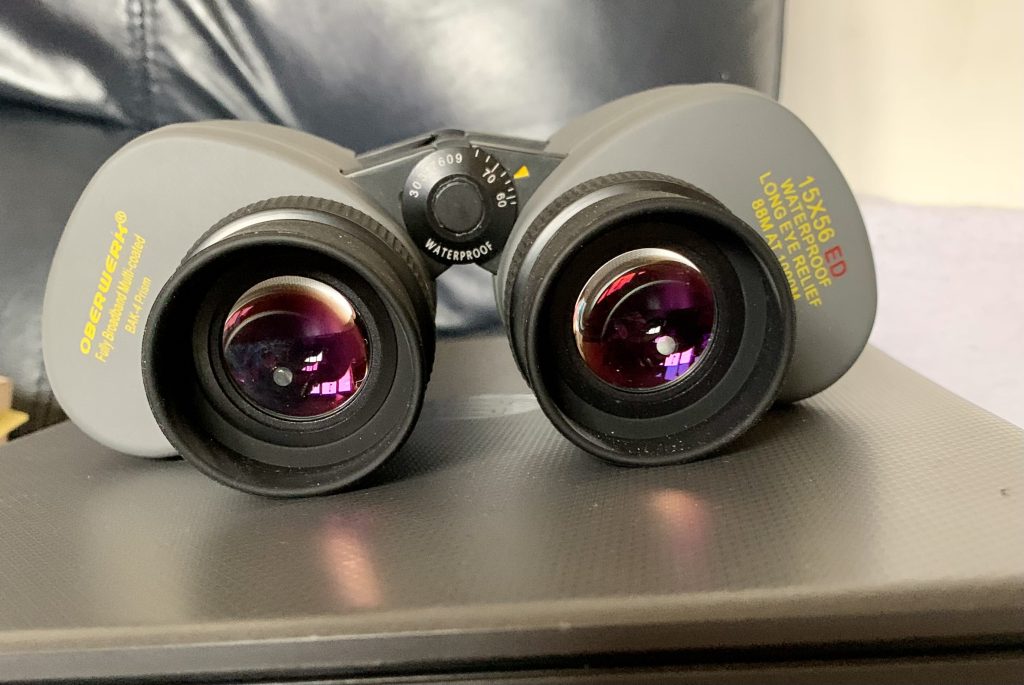
Another neat feature of the 15 x 56 ED Ultra is the easy to read interpupillary distance measure on the bridge which is of great assistance in maintaining the optimal spacing of the eyepieces with one’s eyes.
The central hinge is fashioned from strong metal, rendering adjustments very smooth and precise. Once set, it’s sufficiently rigid to hold its position precisely.
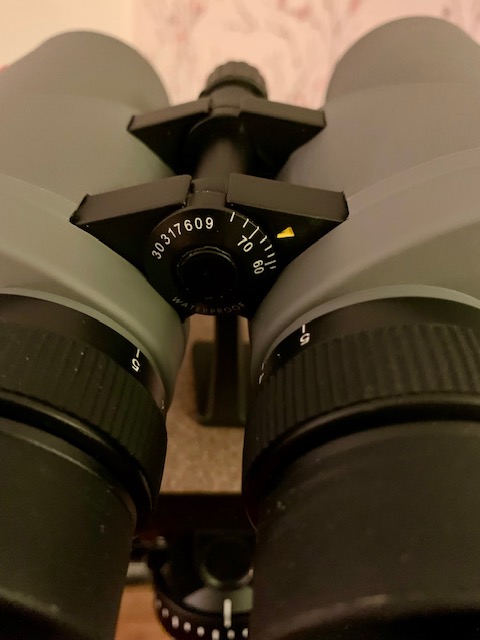
Mounting Options:
The interesting thing about a 15 x 56 configuration is that it’s neither lightweight or overly heavy. That means it can be enjoyed handheld or mounted. I used a simple, Rick Young harness to transport the instrument while exploring the rural landscape near my home. A binocular harness distributes the weight of the binoculars more evenly across your body, reducing strain on your arms and hands. This allows for a more stable hold, especially during prolonged use.
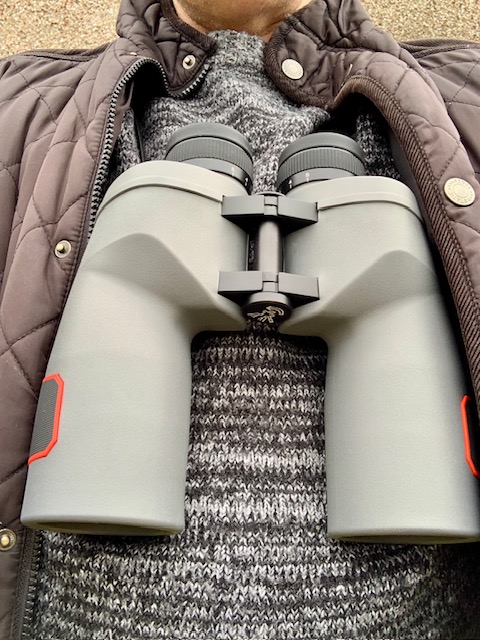
In addition, there’s less chance for hand tremors or involuntary movements to affect what you’re viewing. This is particularly beneficial for observing distant or moving objects. What’s more, using a harness can encourage better posture, as it allows the user to maintain a more relaxed position while viewing. Proper posture can also help in reducing fatigue, which in turn helps maintain steady vision. All in all, these ergonomic features collectively help stabilise viewing through the Oberwerk ED Ultra 15 x 56.
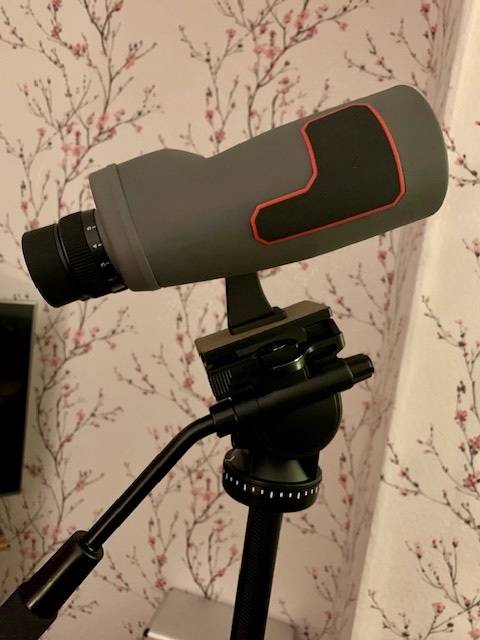
Another option is to mount the binocular on a sturdy photographic tripod via the supplied bracket. While this is a good way to obtain steady views for terrestrial viewing, I found it rather inconvenient for astronomical observing, preferring instead a sturdy monopod. I elected to use Oberwerk’s excellent Series 2000 monopod with its trigger grip head for easy adjusting both in altitude and azimuth.
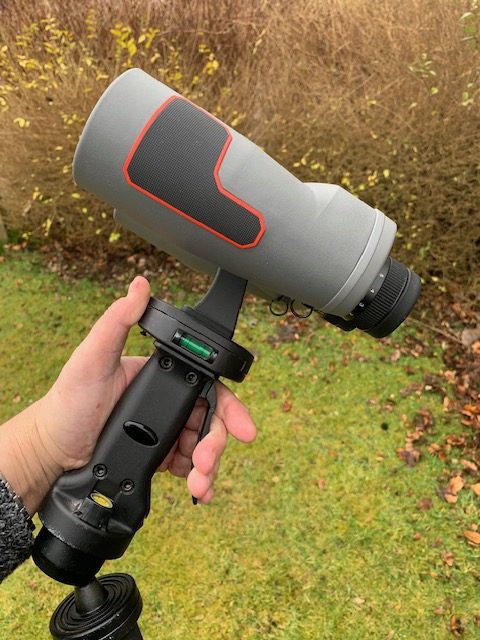
Optics:
The Oberwerk 15 x 56 ED Ultra is of unquestionable optical quality. It displays a very sharp, high-contrast and colour-pure image all the way from the centre to the field stops. Collimation of the barrels was spot on. Chromatic aberration is vanishingly low across the vast majority of the expansive 70-degree apparent field of view, with only the outer extremities showing up a little lateral colour. The extent to which chromatic aberration has been suppressed was immediately apparent when I compared it to the view through a tripod-mounted 15 x 70 Helios Apollo, which showed much higher levels of colour fringing on the same terrestrial targets. The addition of an FK-61 low dispersion objective element sure works wonders reducing blue/violet fringing to an absolute minimum.
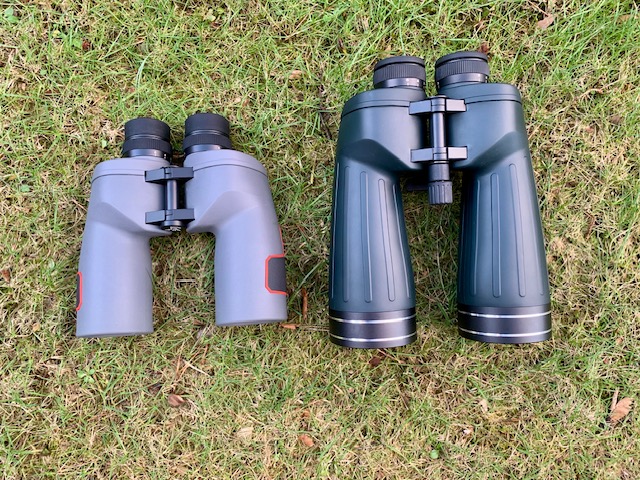
As well as great edge sharpness from the field-flatteners, the Oberwerk 15 x 56 ED Ultra has very low pincushion distortion in the outer field, which should endear it those who like to study architectural features on buildings. At this high magnification, the 15 x 56 serves up a powerful 3-D effect in the middle distance owing to the large separation of the objectives, increasing the spatial information received by the eye.
Pointing the instrument at a bright street light after dark revealed only very slight internal reflections in the Oberwerk 15 x 56 ED Ultra. It also performed very well against natural light, with excellent control of glare.
Notes from the Field:
I measured close focus with a laser rangefinder at 17.4 metres: just a little longer than advertised. The instrument feels great in my medium sized hands. For extra hand-held stabilisation, I found holding the end of the barrels near the objective lenses to afford the most relaxing views.
The extra reach of a 15x glass came in very handy in the identification of smaller birds at my local pond. On one occasion, I glassed a Common Teal( not so common around these parts), and a Little Grebe which were easily identified with the pin sharp, high-magnification views served up by the Oberwerk ED Ultra.

I also found this glass ideal for monitoring a Grey Heron nest in a conifer tree just beyond my back garden. To get a good view, I needed to set up about 150 yards away and the 15x afforded me a perfect perspective far enough away so as not to disturb them.
On another afternoon walk along a quiet country road, I chanced upon a small bird, perched on a prominent branch of a hedgerow about 30 metres in the distance. At first glance, I thought it was a Sparrow, but once I tweaked the focus on the eyepieces on the Oberwerk ED Ultra 15 x 56, I was enthralled to discover that this was a species I had never laid eyes on before: a beautiful Reed Bunting, in all its glory!

A large and powerful glass such as the Oberwerk 15 x 56 ED Ultra really comes into its own monitoring expansive, open waters. I took the instrument over to Balmaha, on the shores of Loch Lomond, one bright morning, to scan the waters for wildlife. Sure enough, I soon chanced upon a small group of noisy Greylag Geese as they took to flight, low, over the waters. I used my monopod to obtain a rock steady view as they made their approach, passing us by about 50 metres out from the shore. Further glassing of the loch showed up some Whooper Swans, leisurely swimming near one of the islands. The excellent optical quality and generously wide field of view made their identification easy with their long, elegant necks and bright yellow bills gleaming in the weak, late winter sunlight.

I can report one minor niggle with the Oberwerk ED Ultra: the rain guard is a nightmare to put on while the rubber eyecups are folded down. As a result, I used a better fitting guard during all my field work.
Adventures Under the Stars:
I chose the Oberwerk ED Ultra 15 x 56 not only for its excellent daylight performance, but also to explore its potential under the starry heavens. My previous experience with other 15x and 20x glasses with 70mm or 80mm objectives had whet my appetite for observing many of the showpiece objects of the winter sky. And it didn’t disappoint!
First a few words about the specifications of the instrument. My extensive prior experiences with a Nikon EII 10 x 35 convinced me that celestial objects look their best with smaller exits pupils. The sky background is darker in these sub-4mm exit pupils but the extra aperture of the 15 x 56 gathers plenty of starlight, making open clusters sparkle beautifully against the night sky. Furthermore, the complete absence of even slight diffraction spikes in this high-quality Porro prism binocular produces comely, pinpoint stars that are most endearing to the eye. As I explained in my book, Choosing and Using Binoculars, another advantage of smaller exit pupils is that they use the best part of your eye to image the subject.
My first target was the Moon. I’m delighted to say I’ve observed it through much of its waxing phases, from slender crescent, all the way to its brilliant fullness. The view through the ED Ultra is superb: clean, crisp and with absolutely no colour aberration in the centre of the field. Only by moving the Moon to the edges of the field of view did I see some very modest lateral colour: blue nearest the centre and yellow furthest from the centre.
Indeed, lunar details, particularly leading up to first quarter phase, were arguably the finest I’ve ever seen in a larger aperture binocular!
There is a modest drop in illumination near the field edges but the image remains tack sharp even at the field stops. Jupiter is also a great test for false colour fringing and I was relieved to see that its tiny creamy white disk showed none across much of the field of view.
Exploring darker skies with no Moon on the sky, I tested how well Arcturus looked as I moved it from the centre of the field to the edge. The field flattening optics built into the eyepieces certainly were doing their job, as the bright orange star remained tightly focused throughout.
I enjoyed wonderful views of the Belt Stars of Orion and the magnificent Sword Handle, the generous AFOV of the ED Ultra presenting exceptionally relaxing and immersive vistas. The views served up by the Ultra ED take you well beyond the performance level of a 10 x 50. The Pleiades and main parts of the Hyades were glorious, sinking into the western skies during late winter. With the constellation of Cancer now at the meridian, I enjoyed framing the beautiful Beehive cluster at the heart of Praesepe, which was just framed by the 4.7 degree true field of the binocular.
I cherished many spell-binding evenings lying back in a zero gravity chair, handholding the instrument, studying the Perseus Double Cluster and the blizzard of stars surrounding Alpha Persei. Kemble’s Cascade in Camelopardalis approached the zenith in early February. Now orientated north to south, its visually stunning linear array of suns dominated the field of the ED Ultra, with room to spare.
Bright Messier open clusters were impressively rendered in the 15 x 56 too: M35 in Gemini was well resolved, as were M36, 37 and 38 across the belly of Auriga. With the arrival of Leo near the meridian late on March evenings, the ED Ultra made light work of picking up the Spring galaxies of M95, 96 and 105 in the same field of view. The generous light gathering power of this instrument was also able to easily glass the bright galaxy pair – M65 & 66 some 8 degrees further to the east.
One final reason I settled on a 15 x 56 format is that it serves up far more aesthetically pleasing views of the twilit heavens. From mid-May through mid-July, there is no true darkness at my far northerly latitude(56 degrees north). Having a smaller exit pupil renders the background sky darker, allowing the summer stars to be viewed with more contrast and thereby enhancing the views. I ‘discovered’ this while using a 10 x 35 Nikon Porro, and very much look forward to seeing what this much larger and more powerful glass will do during my summer vacations.
Conclusions & Recommendations:
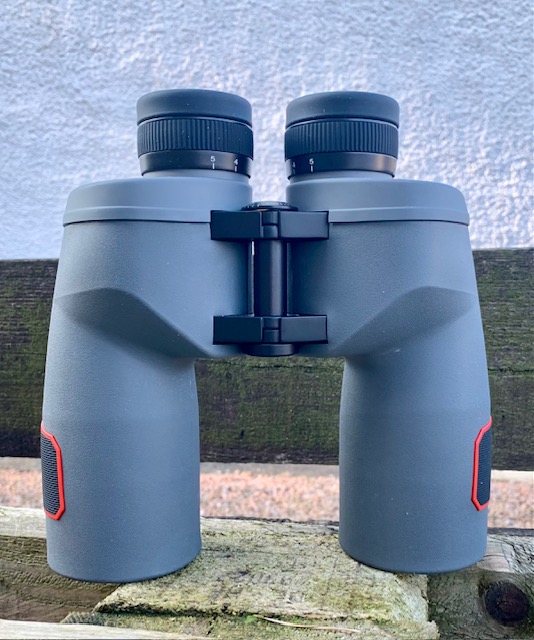
The Oberwerk Ultra ED 15 x 56 has proven to be an exceptionally versatile performer in my experience, being of great utility both in daylight applications and under the stars. While a monopod or tripod can be employed to obtain the most stable views, it’s also small enough to be enjoyed hand-held for extended periods of time.
The Oberwerk Ultra ED series takes Porro prism binocular design to new heights of optical performance, with excellent colour correction, wider fields of view, much improved contrast and thoroughly immersive flat field technology. These advances are also coupled with superior ergonomics with their robust, magnesium alloy chassis, improved 3-point floating plate prism housings and sealed, gas-purged interiors. I’m especially pleased to see that Oberwerk now back these instruments up with an extended 5-year warranty too, which will only serve to improve consumer confidence. I would heartily recommend the 15 x 56 Ultra ED to outdoor enthusiasts and amateur astronomers alike, keen to get the best bang for their hard-earned bucks, and which likely compares favourably to the best roof prism models on the market, but for a fraction of their high retail prices.
What’s not to like?
Dr Neil English discusses many more binocular models from all genres in his new book, Choosing & Using Binoculars.